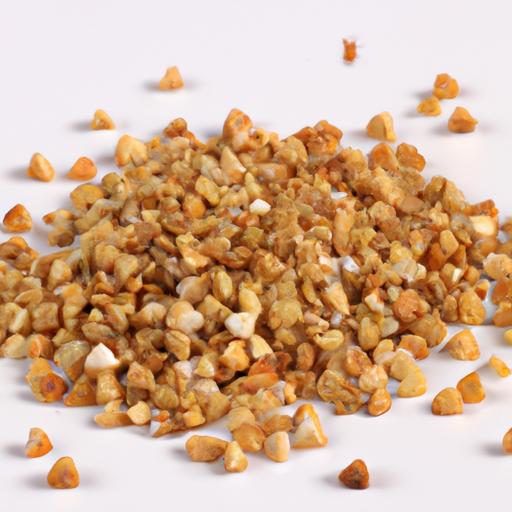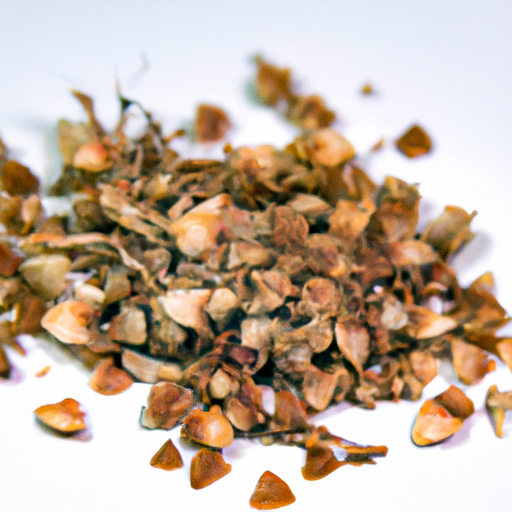Can I Eat Expired Tartary Buckwheat?
Safe to eat up to 30 days after expiry
✅Fresh Tartary Buckwheat

⚠️Spoiled Tartary Buckwheat

🎥Watch: Tartary Buckwheat Storage Guide
Learn expert tips for storing tartary buckwheat safely and extending its shelf life.
Storage Guidelines
Storage Location
Pantry
Ideal Temperature
Room temperature
Best Storage Method
Sealed container in a cool, dry place
Shelf Life
Average Shelf Life
365 days
Extended Shelf Life (When Frozen)
180 days
Signs of Spoilage
Mold or unusual odor
Additional Information
Alternative Uses
Can be ground into flour for baking
Possible Substitutions
Can be used in recipes that call for regular buckwheat
Frequently Asked Questions
What's the difference between expiration and best quality dates?
▼
Hey there! So, let's chat about expiration dates versus best quality for Tartary Buckwheat. The expiration date indicates when the product may no longer be safe to eat due to potential spoilage or degradation of quality. On the other hand, the best quality date suggests when the product is at its peak taste and texture. If you see an expiration date on your Tartary Buckwheat, it's best not to consume it past that point for safety reasons. However, if it has a best quality date, the product may still be safe to eat after that date, but the taste and texture might not be as good. For example, if you have Tartary Buckwheat that has passed the best quality date, it may still be okay to use in dishes like soups or stews where the texture is less important. Personally, I'd follow the expiration date for safety, but don't hesitate to use Tartary Buckwheat past its best quality date if it still looks and smells fine – just be prepared for a slight change in taste or texture.
How can I tell if Tartary Buckwheat has gone bad?
▼
To tell if Tartary Buckwheat has gone bad, look for any signs of mold or discoloration on the grains. Check for any unusual or off-putting smells, as a rancid or sour odor is a clear indicator of spoilage. Additionally, feel the texture of the buckwheat - if it feels mushy, slimy, or sticky, it is likely no longer safe to eat.
What are the food safety risks?
▼
Hey there! When it comes to Tartary Buckwheat, there are some foodborne illness risks you should be aware of. This nutritious grain-like seed has a unique earthy flavor and is great for your health, but handling it safely is key to avoid any unpleasant experiences. One common risk is cross-contamination. If you're using Tartary Buckwheat in your kitchen, make sure to keep it separate from raw meats and poultry to prevent bacteria transfer. Symptoms of foodborne illnesses can range from mild stomach discomfort to more serious issues like vomiting and diarrhea. So, it's crucial to store and cook Tartary Buckwheat properly. To stay safe, always wash your hands before and after handling Tartary Buckwheat, cook it to the recommended temperature, and store it in a cool, dry place. If you notice any unusual smell or discoloration, it's better to toss it out than take a risk. Remember, a little caution goes a long way in enjoying your delicious Tartary Buckwheat dishes without any worries!
What are some pro storage tips?
▼
Hey there! Tartary Buckwheat is a fantastic ingredient, and proper storage is key to keeping it fresh. Here are some practical storage hacks and pro tips for you: 1. **Airtight Containers:** Store your Tartary Buckwheat in airtight containers to prevent moisture from getting in and affecting its texture and flavor. 2. **Cool, Dark Place:** Keep your buckwheat in a cool, dark place like a pantry to maintain its quality. Avoid storing it in warm or humid areas. 3. **Labeling:** Use labels to indicate the purchase date on your container. This way, you can track how long it's been in storage and ensure you use it before it goes past its prime. 4. **Freezer Friendly:** If you want to extend the shelf life of your Tartary Buckwheat, consider storing it in the freezer. Just make sure to use a freezer-safe container or bag. 5. **Creative Storage:** If you're short on pantry space, consider using mason jars or clear containers to store your buckwheat. Not only will it keep it fresh, but it'll also look pretty on your shelves! I've personally found that storing Tartary Buckwheat in glass jars in a cool pantry works wonders. It's a versatile ingredient, so having it on hand is always a plus. Hope these tips help you keep your buckwheat fresh and ready to use!
Any interesting facts about Tartary Buckwheat?
▼
Hey there! Let's chat about Tartary Buckwheat, a unique and nutritious little grain. Did you know that this ancient crop has been cultivated for over 4,000 years in the Himalayan region? It's not just a regular buckwheat; it's like the cool cousin with extra health benefits! In terms of cultural significance, Tartary Buckwheat is often used in traditional Asian cuisines, especially in regions like China, Japan, and Korea. It's not just tasty; it's also packed with nutrients like antioxidants, fiber, and essential minerals. Here's a fun fact: in some regions, Tartary Buckwheat is considered a symbol of good luck and prosperity. People believe that consuming it can bring blessings and abundance. How cool is that? So next time you come across Tartary Buckwheat in a recipe or at the store, give it a try! Not only will you be adding a unique flavor to your dishes, but you'll also be tapping into a long history of culinary tradition and cultural significance. Enjoy exploring the world of Tartary Buckwheat!
Can I eat Tartary Buckwheat if it's been at room temperature for a day?
▼
If Tartary Buckwheat has been left at room temperature for a day, it's best to discard it. Bacteria can multiply rapidly at room temperature, increasing the risk of foodborne illness. To ensure food safety, avoid consuming Tartary Buckwheat that has been left out for extended periods.
How long after opening can I safely eat Tartary Buckwheat?
▼
Once opened, Tartary Buckwheat can be safely consumed within one year if stored properly in an airtight container in the pantry. Ensure the packaging is resealed tightly after each use to maintain freshness and prevent moisture absorption. Discard any Tartary Buckwheat that shows signs of spoilage, such as an off odor or mold growth.
Does freezing affect the texture of Tartary Buckwheat when thawed?
▼
Freezing Tartary Buckwheat can alter its texture slightly when thawed. The grains may become slightly softer or stickier compared to freshly cooked Tartary Buckwheat. To minimize texture changes, consider slightly undercooking the Tartary Buckwheat before freezing. Properly sealed and stored frozen Tartary Buckwheat can maintain its quality for an extended period.
Do different brands of Tartary Buckwheat have varying shelf lives?
▼
The shelf life of Tartary Buckwheat is generally consistent across different brands when stored properly. However, variations in packaging quality and storage conditions during transportation can impact the overall freshness of the product. Always check the expiration date and storage recommendations on the package to ensure optimal quality and safety.
How does cooking Tartary Buckwheat affect its expiration?
▼
Cooking Tartary Buckwheat does not significantly impact its expiration date. The expiration date primarily depends on the storage conditions and packaging integrity. Properly cooked Tartary Buckwheat can be stored in the refrigerator for up to 3-5 days or frozen for longer-term storage. Ensure leftovers are promptly cooled and stored to maintain freshness and prevent bacterial growth.
Does Tartary Buckwheat last longer in summer or winter?
▼
Tartary Buckwheat typically lasts longer in winter due to the cooler temperatures, which help inhibit bacterial growth and slow down the rate of spoilage. In contrast, summer heat can accelerate food deterioration, shortening the shelf life of Tartary Buckwheat if not stored in a cool, dry place. Always store Tartary Buckwheat away from direct sunlight and sources of heat to preserve its quality.
How can I safely transport Tartary Buckwheat for a long journey?
▼
When transporting Tartary Buckwheat for an extended period, it's crucial to keep it in a sealed, airtight container to prevent exposure to moisture and contaminants. Consider using a cooler bag or insulated container with ice packs if traveling in warm weather to maintain the freshness of the Tartary Buckwheat. Avoid leaving the Tartary Buckwheat in a hot car or direct sunlight during transport to prevent spoilage.
Expiration Calculator
Sources
For more information on food safety and expiration guidelines, visit our Sources page.
Scan your food directly and get instant safety info using our AI-powered camera feature.
Recipes Available
We have recipes that can help you safely use tartary buckwheat past its expiration date!
View Recipes →Similar Storage Requirements
Dried Thyme
Cooking Ingredients
View expiration date and storage guide →
Almond Paste
Baking Supplies
View expiration date and storage guide →
Coffee Beans
Beverages
View expiration date and storage guide →
Honey Dijon Salad Dressing Commercially Bottled Sold Unrefrigerated Opened
Condiments & Spices
View expiration date and storage guide →
Malt Powder
Baking Supplies
View expiration date and storage guide →
Cornstarch
Cooking Ingredients
View expiration date and storage guide →
Cooking Spray Vegetable Oil Spray
Baking Supplies
View expiration date and storage guide →
Mango Nectar Unrefrigerated Unopened
Beverages
View expiration date and storage guide →
Red Wine Vinaigrette Salad Dressing Commercially Bottled Sold Unrefrigerated Opened
Condiments & Spices
View expiration date and storage guide →
Reviewed By: Food Safety & Expiration Experts
At Can I Eat Expired, we are committed to providing accurate, science-backed information about food expiration and storage safety. Our content is carefully reviewed based on guidelines from leading food safety organizations, including:
- ✅U.S. Food & Drug Administration (FDA) – Food Safety Guidelines
- ✅United States Department of Agriculture (USDA) – Food Storage & Expiration Dates
- ✅World Health Organization (WHO) – Foodborne Diseases & Safety
- ✅Centers for Disease Control & Prevention (CDC) – Preventing Foodborne Illness
🔍 How We Ensure Accuracy
- We use official food safety sources to guide our recommendations.
- Our team continuously reviews and updates content based on the latest research.
- We encourage users to always check for signs of spoilage and follow proper storage guidelines.
📚 Have Questions?
If you have specific concerns about food expiration or safety, we recommend consulting a registered dietitian, food scientist, or your local health department.
Note: These are general guidelines. Always use your best judgment and when in doubt, throw it out.